
A flying car or roadable aircraft is a type of vehicle which can function both as a road vehicle and as an aircraft. As used here, this includes vehicles which drive as motorcycles when on the road. The term "flying car" is also sometimes used to include hovercars and/or VTOL personal air vehicles. Many prototypes have been built since the early 20th century, using a variety of flight technologies. Most have been designed to take off and land conventionally using a runway. Although VTOL projects are increasing, none has yet been built in more than a handful of numbers.

An autogyro, or gyroplane, is a type of rotorcraft that uses an unpowered rotor in free autorotation to develop lift. While similar to a helicopter rotor in appearance, the autogyro's unpowered rotor disc must have air flowing upward across it to make it rotate.
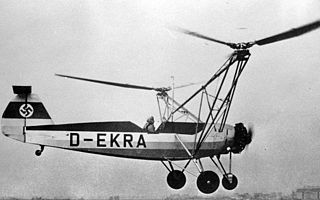
The Focke-Wulf Fw 61 is often considered the first practical, functional helicopter, first flown in 1936. It was also known as the Fa 61, as Focke began a new company—Focke-Achgelis—in 1937.
The CarterCopter is an experimental compound autogyro developed by Carter Aviation Technologies in the United States to demonstrate slowed rotor technology. On 17 June 2005, the CarterCopter became the first rotorcraft to achieve mu-1 (μ=1), an equal ratio of airspeed to rotor tip speed, but crashed on the next flight and has been inoperable since. It is being replaced by the Carter Personal Air Vehicle.

The Bensen B-8 is a small, single-seat autogyro developed in the United States in the 1950s. Although the original manufacturer stopped production in 1987, plans for homebuilders are still available as of 2019. Its design was a refinement of the Bensen B-7, and like that aircraft, the B-8 was initially built as an unpowered rotor-kite. It first flew in this form in 1955, and on 6 December a powered version, designated B-8M first flew. The design proved to be extremely popular and long-lasting, with thousands of sets of plans sold over the next thirty years.
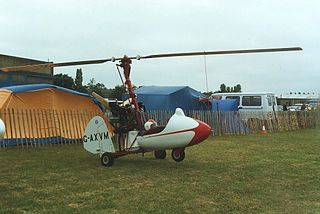
The Layzell Cricket is a single-seat autogyro produced in the United Kingdom for homebuilding, although it was first produced in the early 1970s fully factory-built. It was a typically minimalist design, featuring a pilot's seat semi-enclosed within a fairing, and a pusher engine and large tailfin located aft of the rotor mast. Forty-three of the original Crickets were built by Campbell Aircraft, with the type enjoying a brief revival in 2001 when it was marketed in kit form by Mike Concannon of Cricket Gyroplanes, before reaching production again in 2005 by Layzell Gyroplanes as the Mk.6.

The Pitcairn PCA-2 was an autogyro developed in the United States in the early 1930s. It was Harold F. Pitcairn's first autogyro design to be sold in quantity. It had a conventional design for its day – an airplane-like fuselage with two open cockpits in tandem, and an engine mounted tractor-fashion in the nose. The lift by the four-blade main rotor was augmented by stubby, low-set monoplane wings that also carried the control surfaces. The wingtips featured considerable dihedral that acted as winglets for added stability.

The RotorSport UK MT-03 is a two-seat autogyro manufactured to British Civil Airworthiness Requirements CAP643 Section T. New build-aircraft based on the AutoGyro MT-03 design are imported from Germany and completed to British regulations by RotorSport UK Limited in the United Kingdom.
The Avian 2/180 Gyroplane was a two-seat, single-engine autogyro built in Canada in the 1960s. Several prototypes were built but production was not achieved.
The Ekin WHE Airbuggy is a British single-seat autogyro designed and built by the W. H. Ekin (Engineering) Company in Northern Ireland.

The Magni M-16 Tandem Trainer is an Italian sport autogyro, seating two in tandem, designed and produced by Magni Gyro srl of Besnate. It and the M-22 Voyager, a touring variant with baggage space and increased endurance, remain in production in 2010 with over 150 sold.

The KB-2 Freedom Machine is an autogyro designed by Ken Brock based on the designs of the Bensen B-8.
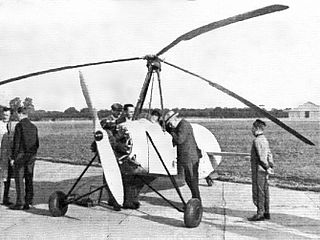
The Hafner A.R.III Gyroplane was a British 1930s experimental autogyro designed by Austrian Raoul Hafner, and built by the A.R.III Construction Company at Denham, Buckinghamshire.
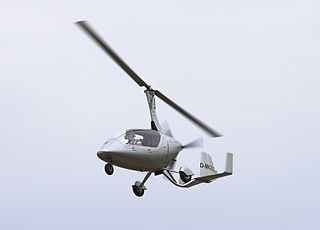
The RotorSport Calidus is a German tandem two-seater autogyro modified in the UK to meet British Civil Airworthiness Requirements CAP643 Section T. The Calidus is an enclosed-cockpit development of the open-cockpit RotorSport UK MT-03. New-build AutoGyro Calidus aircraft are imported from the manufacturers, AutoGyro GmbH in Hildeshem, Germany and completed to British regulations by RotorSport UK Ltd.
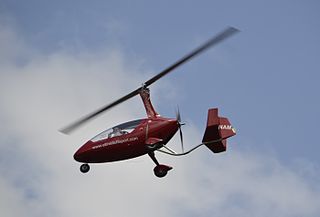
The AutoGyro Calidus is a German autogyro, designed and produced by AutoGyro GmbH of Hildesheim. The aircraft is supplied as a complete ready-to-fly-aircraft.
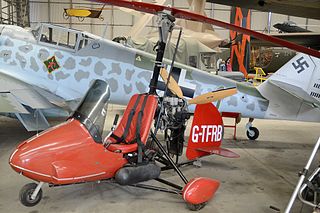
The Air Command Commander Elite is an American autogyro that was designed and produced by Air Command International of Caddo Mills, Texas. When it was available the aircraft was supplied as a kit for amateur construction or as a conversion kit for the earlier Air Command Commander.

The AutoGyro MT-03 is a German autogyro, designed and produced by AutoGyro GmbH of Hildesheim. The aircraft is supplied as a complete ready-to-fly-aircraft.

The Cierva C.7 was an experimental autogiro designed by Juan de la Cierva and built in the late 1920s.

The 1933 experimental Pitcairn PA-22 was one of the first wingless autogyros. It was controlled by movement of the rotor plane rather than the usual control surfaces, though initially the much modified lone example retained rudders as a precaution.
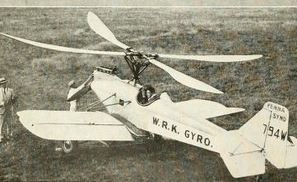
The Wilford Gyroplane was based on a German autogyro first flown in 1926. After E. Burke Wilford bought the rights and patents, it was developed in the US until 1936.




















